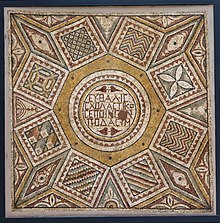Synagogue of Apamea


The Synagogue of Apamea was an ancient synagogue in Apamea on the Orontes . It was located on the great Kolonnadenstrasse ( Cardo ) southeast of the intersection with the Decumanus , so in a very central location. It was built in the late 4th century, but destroyed after a few decades.
Research history
The synagogue was excavated in 1934 during the fourth excavation campaign of the Mission Archaeologique Belge led by Fernand Mayence . Since an inscription mentions the year 703 of the Seleucid era (392 AD), the mosaic floor could be precisely dated. However, the excavation reports of the Belgian team were destroyed in two fires in the Musée du Cinquantenaire in Brussels in 1944 and 1946, so only the preliminary reports have been preserved.
Building description, mosaic floor and inscriptions
The main room measured 15.5 × 9 meters and had a square niche in the south wall, which probably served as a Torah shrine . The floor is covered with several mosaics that are purely geometrical except for a menorah . In this respect, the synagogue deviates from the synagogue-building tradition in Syria and Palestine , "which tended towards pictorial representations on mosaic floors."
The numerous Greek inscriptions are unique and indicate how many feet of the mosaic floor were donated by a donor or in honor of a family.
The following appear as dignitaries: the chairman of the Antiochen Council of Elders, several synagogue rulers , an elder (presbyter), a chasan and a deacon. Nine times women appear as donors alone and three times together with their husbands.
Successor building
In the fifth century, the atrium church, also known as the cathedral and consecrated to Kosmas and Damian, was built over the destroyed synagogue, initially a simple apse room. It was enlarged and embellished after the earthquakes 526 and 528. "The deliberate conversion of diaspora synagogues into churches demonstrates the political power that Christianity had now gained."
literature
- Lee I. Levine: The Ancient Synagogue: The First Thousand Years. Yale University Press 2005. ISBN 0-300-07475-1 . Pp. 258-260.
- Eleasar L. Sukenik: The Mosaic Inscriptions in the Synagogue at Apamea on the Orontes. In: Hebrew Union College Annual 23 (1950-1951), pp. 541-551.
Web links
- Adam Blitz: Ghosts of Apamea . In: The Times of Israel , April 28, 2014 (Reprinted from Jewish Quarterly , 61: 1, pp. 24-27)
Individual evidence
- ^ David Noy, Walter Ameling, Hanswulf Bloedhorn: Inscriptiones Judaicae Orientis: Syria and Cyprus . 2004, p. 113 .
- ^ Andreas Feldtkeller: Syria . Leipzig 2011, p. 109 .
- ↑ Rachel Hachlili: Ancient Jewish Art and Archeology in the Diaspora . Brill, Leiden 1998, pp. 93 .
Coordinates: 35 ° 24 ′ 56.7 " N , 36 ° 24 ′ 8.5" E